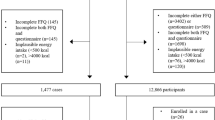Abstract
Background: Dietary factors are known to be associated with initiation and development of colorectal cancer (CRC), and also with CRC's major precursor, the colorectal polyp. In long-term intervention studies on colorectal polyps, dietary changes may therefore affect potential effects of the study intervention.
Objective: To examine potential dietary changes among polyp-patients randomly selected from a 3 y intervention study after 1 y.
Design and subjects: Of 116 polyp-bearing out-patients (50% men), aged 50–76 y, who participated in the double-blind 3 y placebo-controlled endoscopic follow-up and intervention study against growth and recurrence of polyps, 30 patients were randomised (strata: sex, age and polyp size) to perform a repeated 5 day dietary record by weighing after 1 y. The patients received a daily mixture of vitamin C (150 mg), α-tocopherol (75 mg), β-carotene (15 mg), selenium (101 µg) and calcium (1.6 g) or placebo (lactose) for a period of 3 y with annual colonoscopic examinations and polyps size measurements to test if the mixture was able to reduce polyp growth and recurrence. Polyps of >9 mm were removed, whereas the remainders and new discoveries of polyps <9 mm were left in situ until the end of the study.
Results: Twenty-nine patients agreed to perform the repeated 5 day dietary record, and 86% performed the second record within 48–58 weeks after the first record. The results showed that, with the exception of vitamin D, milk and milk products, no significant differences were found between the two records. The median value of the Spearman's correlation coefficient for energy and energy-yielding nutrients was 0.66, for vitamins and minerals 0.58, and for foods 0.58. Individual differences between the records were found for most variables, but most of these were negligible.
Conclusion: After 1 y, no major dietary changes were found which could be associated with a changed susceptibly for malignancy, and thereby affect potential effects of the study intervention. We may thus suggest that a potential changed susceptibility towards growth and recurrence of polyps, is due to the specific intervention, and not due to other major dietary changes.
Sponsorship: The Norwegian Cancer Society and Pronova a/s.
European Journal of Clinical Nutrition (2001) 55, 374–379
This is a preview of subscription content, access via your institution
Access options
Subscribe to this journal
Receive 12 print issues and online access
$259.00 per year
only $21.58 per issue
Buy this article
- Purchase on Springer Link
- Instant access to full article PDF
Prices may be subject to local taxes which are calculated during checkout
Similar content being viewed by others
Author information
Authors and Affiliations
Contributions
Guarantor: MH Vatn.
Contributors: KA was the primary investigator; KT was the advisor on nutritional research; BH was the collaborator on gastroenterology; MBV was the collaborator on statistics; and MHV had responsibility for the project. Each of the co-writers made comments on the manuscript during preparation.
Corresponding author
Rights and permissions
About this article
Cite this article
Almendingen, K., Trygg, K., Hofstad, B. et al. Results from two repeated 5 day dietary records with a 1 y interval among patients with colorectal polyps. Eur J Clin Nutr 55, 374–379 (2001). https://doi.org/10.1038/sj.ejcn.1601166
Received:
Revised:
Accepted:
Published:
Issue Date:
DOI: https://doi.org/10.1038/sj.ejcn.1601166
Keywords
This article is cited by
-
Accumulation and interactions of β-carotene and α-tocopherol in patients with adenomatous polyps
European Journal of Clinical Nutrition (2002)



